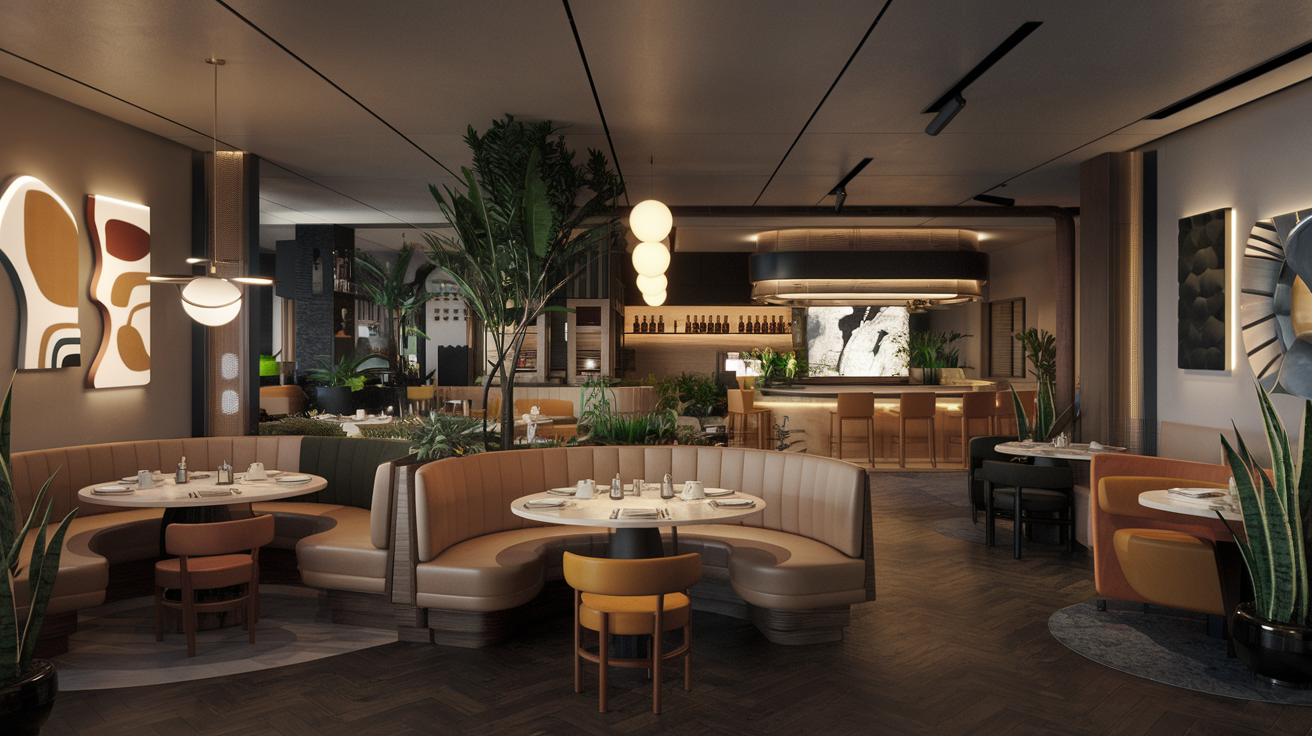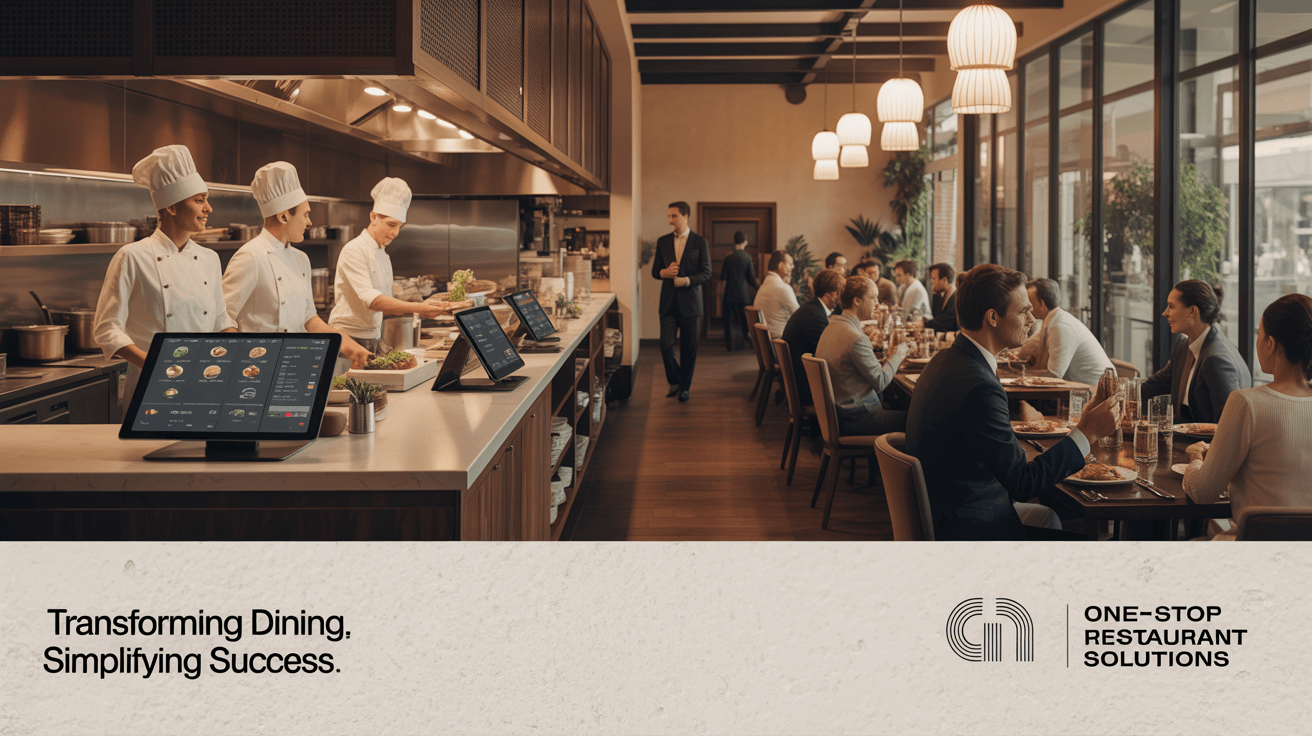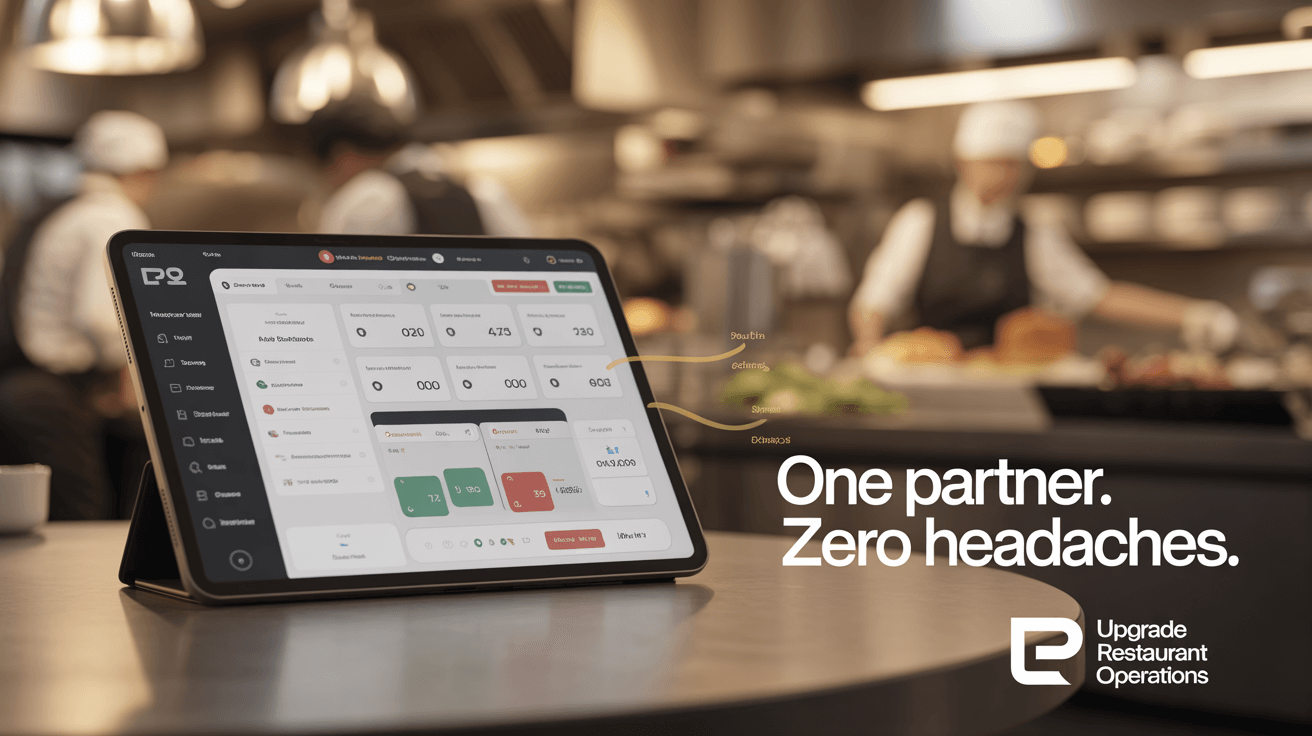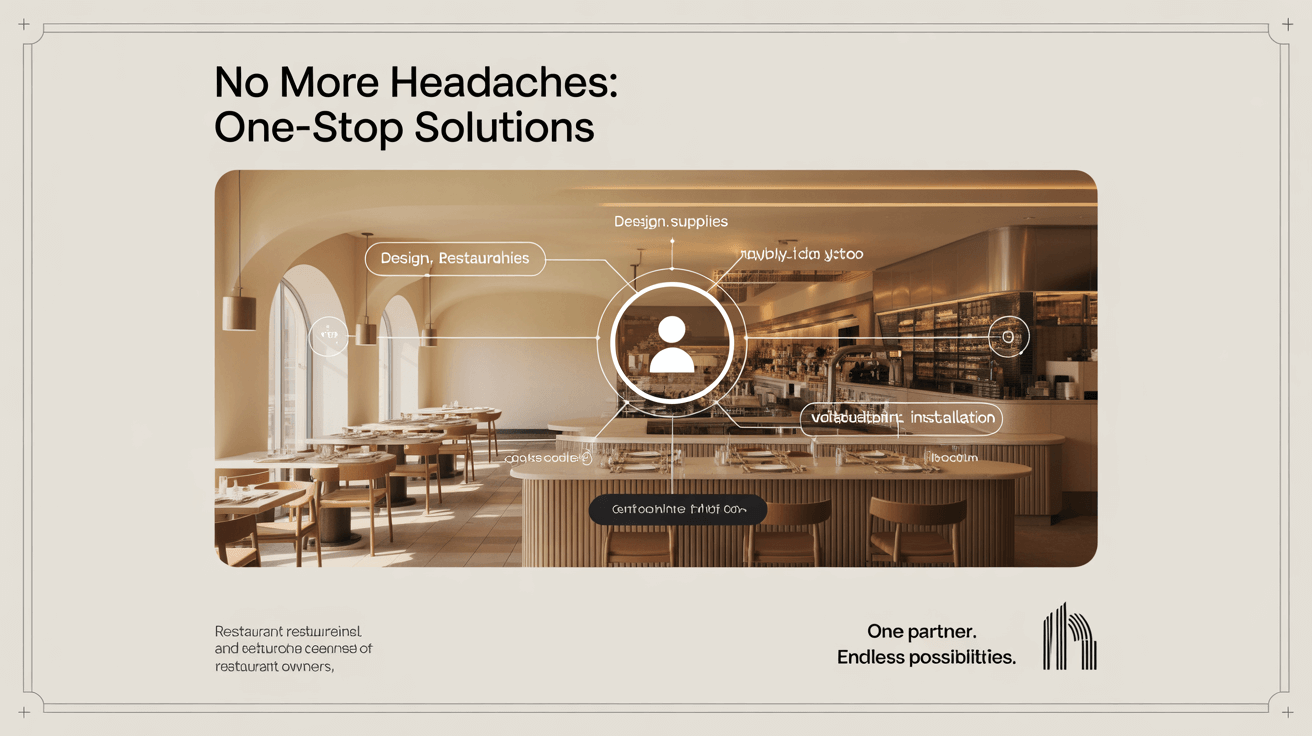Introduction
The way we experience dining is evolving at lightning speed. What was once a simple meal out is now an immersive escape, blending aesthetics, technology, and atmosphere to create something unforgettable. In 2025, interiors are no longer just about looks—they influence mood, enhance comfort, and even drive customer loyalty.
Forget the predictable. The latest spaces are bold, interactive, and deeply personalized. Adaptive seating adjusts to guest flow, lighting responds to energy levels, and biophilic elements breathe life into urban settings. Every detail, from textures to acoustics, is meticulously crafted to leave a lasting impression.
With expectations higher than ever, design has become a silent storyteller, shaping how people feel the moment they step inside. Whether through cutting-edge tech or nostalgic charm, the spaces of tomorrow are redefining hospitality in ways that go far beyond the plate.
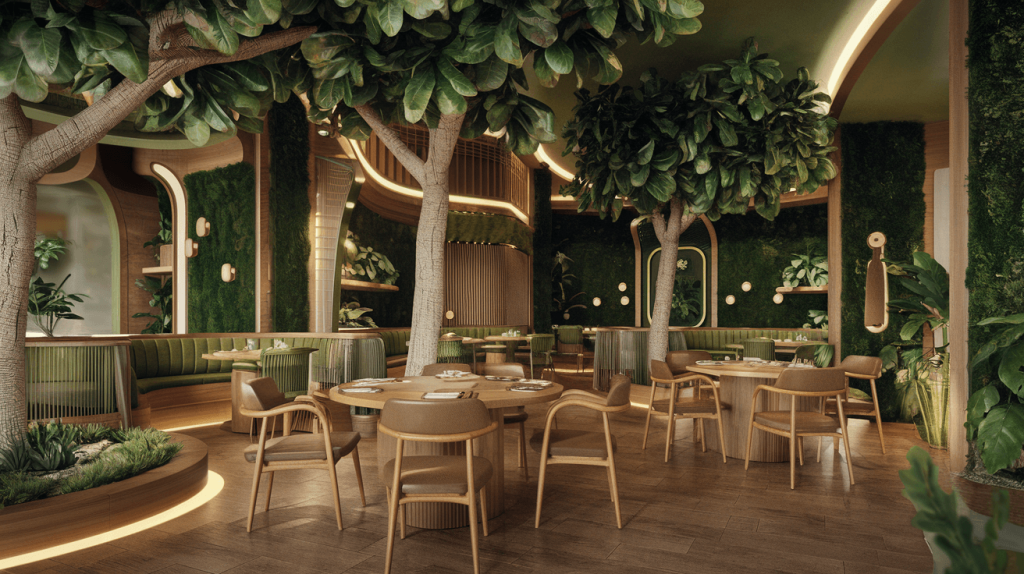
1. Sustainable and Eco-Friendly Designs
The hospitality industry is embracing sustainability like never before. In 2025, eco-conscious spaces are no longer an afterthought—they’re a core element of modern aesthetics and functionality. From salvaged wood to repurposed metals, designers are giving discarded materials new life, crafting interiors that feel both contemporary and responsible.
Energy efficiency is also taking center stage. Smart lighting systems adapt to natural daylight, reducing waste while enhancing ambiance. High-performance appliances are slashing electricity consumption without compromising efficiency. Even furniture is evolving, with biodegradable alternatives replacing synthetic-heavy seating.
Greenery is another defining feature. Living walls aren’t just decorative—they improve air quality, regulate indoor temperatures, and create a serene escape from urban chaos. Vertical gardens, hydroponic installations, and potted trees bring a refreshing contrast to industrial settings, proving that sustainability isn’t just ethical—it’s undeniably stylish.
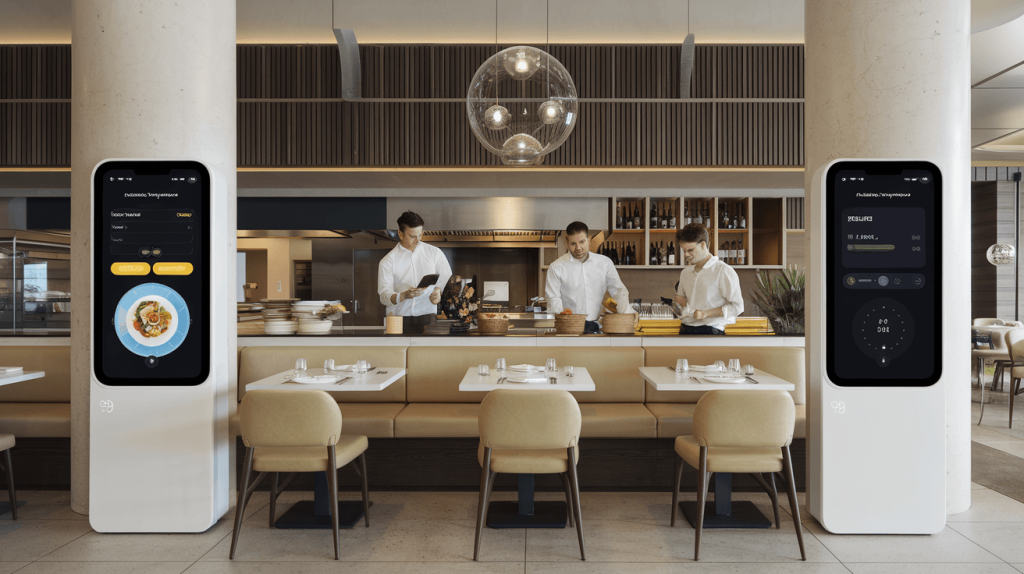
2. Smart Technology Integration
Dining spaces are becoming smarter, faster, and more interactive. Cutting-edge advancements are redefining efficiency, convenience, and personalization, making every visit seamless from start to finish.
AI-powered kiosks are leading the charge, offering guests an intuitive way to browse menus, customize meals, and place orders without waiting for staff. With predictive analytics, these systems can even suggest dishes based on preferences, dietary needs, or seasonal trends, elevating the experience beyond a simple transaction.
Behind the scenes, automation is transforming operations. Robotic servers glide through dining areas, ensuring swift, contact-free service, while AI-driven kitchen assistants maintain precision and speed in food preparation. These innovations aren’t just about spectacle—they optimize workflow, reduce waste, and enhance consistency.
At the table, embedded technology is making an impact. Wireless charging stations are eliminating the need for clunky adapters, while digital displays offer real-time order tracking, entertainment, and even interactive storytelling. Every detail is designed to enhance engagement, making traditional dining feel like a thing of the past.
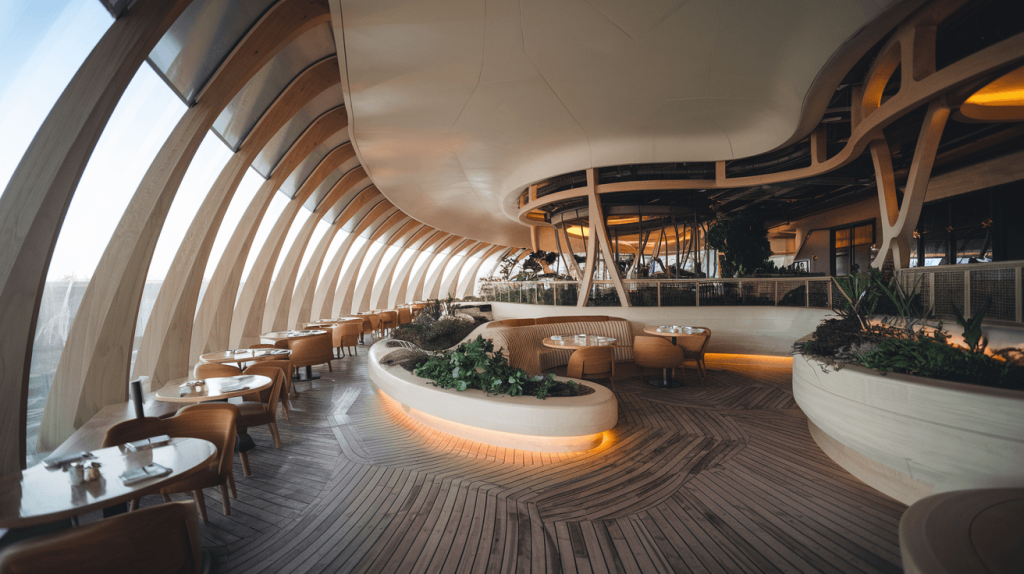
3. Flexible and Modular Spaces
Adaptability is becoming a defining feature of modern hospitality. With evolving customer expectations and shifting business models, versatility is no longer optional—it’s essential.
Multi-purpose layouts are taking center stage, allowing venues to transform effortlessly throughout the day. A breakfast café can transition into a coworking lounge by afternoon and an intimate cocktail setting by night. This fluid approach maximizes space efficiency while catering to diverse audiences.
Movable walls and modular furniture are also revolutionizing layouts. Lightweight dividers create private sections for groups, while adjustable seating arrangements accommodate fluctuating guest counts. This dynamic setup ensures that every square foot serves a purpose, whether hosting a casual gathering or a high-end event.
The fusion of indoor and outdoor elements is another game-changer. Expansive glass doors, retractable roofs, and climate-controlled patios allow guests to enjoy open-air comfort year-round. With a growing preference for fresh air and natural surroundings, adaptable environments are redefining the future of hospitality.
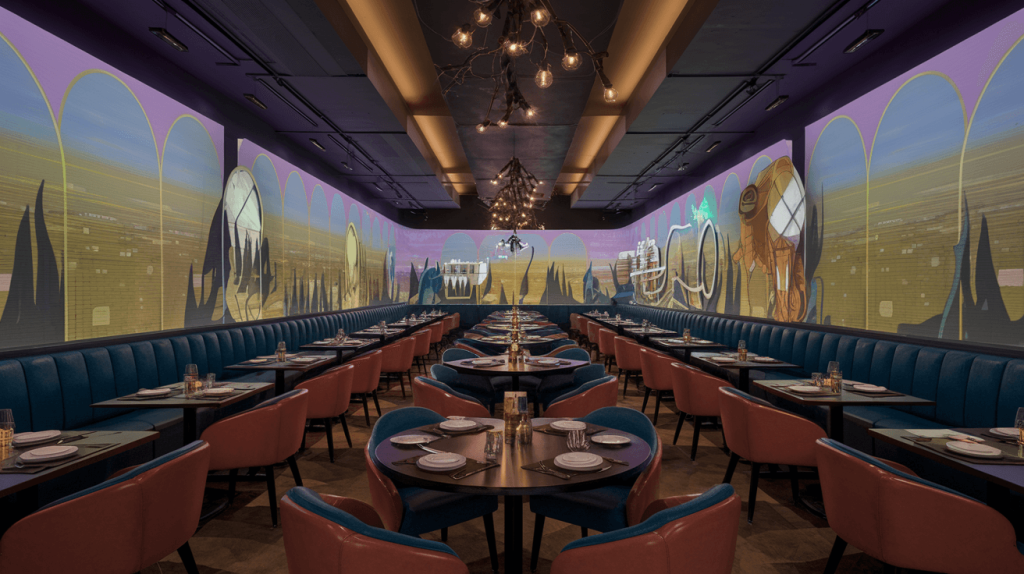
4. Immersive and Experiential Dining Spaces
A meal is no longer just about taste—it’s about stepping into another world. As expectations rise, hospitality is evolving to deliver unforgettable, multi-sensory encounters that go beyond traditional settings.
Themed concepts are leading this transformation. Whether it’s a futuristic sci-fi lounge or a vintage Parisian bistro, curated aesthetics and interactive storytelling transport guests into a carefully crafted atmosphere. From the décor to the staff’s attire, every detail is designed to create a fully immersive escape.
Advanced projection mapping and augmented reality (AR) are elevating ambiance. Tabletops become digital canvases, displaying animated visuals that shift with each course. Walls breathe with ever-changing landscapes, setting the mood in ways static décor never could. These high-tech enhancements turn an ordinary night out into an engaging experience.
Beyond visuals, sensory design is making an impact. Carefully curated soundscapes, subtle aromatic infusions, and textured tableware are being used to heighten emotions and enhance flavors. By appealing to more than just the palate, these elements ensure that every visit is more than a meal—it’s a moment to remember.
5. Minimalist and Zen Aesthetic Designs
Simplicity is making a bold statement. As the world grows increasingly chaotic, hospitality spaces are embracing a calming, clutter-free approach that soothes the senses and enhances the overall experience.
At the core of this movement are clean lines, neutral palettes, and open layouts. By eliminating unnecessary distractions, these interiors create an inviting atmosphere that encourages relaxation. Soft lighting, natural textures, and thoughtfully spaced seating contribute to an effortless sense of balance.
This approach isn’t just about aesthetics—it’s rooted in psychology. Studies show that a well-organized, harmonious setting reduces stress and improves focus, allowing guests to fully engage with their surroundings. By removing excess noise—both visual and physical—these spaces cultivate an environment where comfort takes precedence.
Much of this influence stems from Scandinavian and Japanese design principles. The fusion of warm wood, organic elements, and minimalist decor results in an effortlessly elegant space that feels both contemporary and timeless. In an era where overstimulation is the norm, these serene environments offer a much-needed escape.
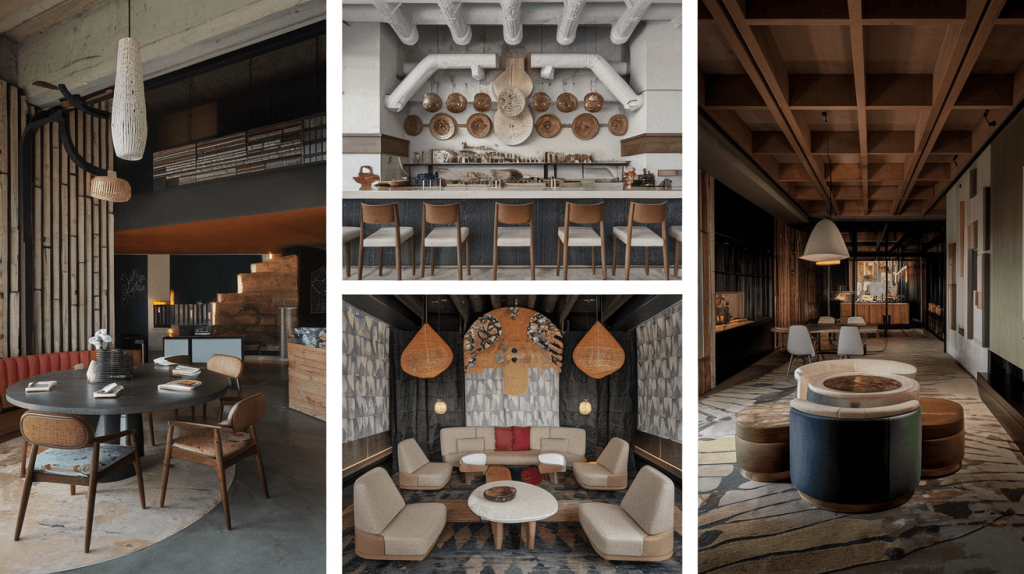
6. The Rise of Hyper-Local and Cultural Influences
Authenticity is taking center stage as establishments move away from generic, one-size-fits-all aesthetics. Spaces are now deeply rooted in local heritage, offering a unique sense of place that resonates with both residents and visitors.
One of the biggest shifts is the emphasis on regional craftsmanship. From hand-carved wooden tables to stone accents sourced from nearby quarries, interiors are embracing locally made materials that reflect the community’s identity. This approach not only enhances character but also supports artisans and sustainable sourcing practices.
Cultural storytelling is also shaping modern hospitality. Whether through indigenous motifs, traditional textiles, or historical architectural elements, these influences create a deeper connection between guests and their surroundings. Rather than following fleeting trends, venues are embedding narratives into their design, making each visit a journey through history and tradition.
Beyond décor, engagement with the local creative scene is growing. Murals from neighborhood artists, installations crafted by skilled makers, and collaborations with regional designers are turning dining spaces into cultural hubs. This fusion of design and heritage is redefining the meaning of authenticity, offering a space where history, artistry, and experience converge.

7. Open Kitchens and Transparency in Design
Diners are no longer satisfied with just good food—they want to see the magic happen. Open-concept layouts are transforming hospitality, creating an engaging atmosphere that fosters trust and excitement.
One of the biggest draws is the ability to watch meals come to life. Seeing chefs at work adds an element of anticipation, turning preparation into part of the overall experience. From handmade pasta being rolled out to fresh seafood sizzling on the grill, every movement enhances the connection between guests and their meals.
Beyond entertainment, these layouts elevate presentation. Theatrical stations, complete with wood-fired ovens, sushi counters, or teppanyaki grills, immerse visitors in the artistry behind each dish. The sound of chopping, the sizzle of a pan, and the aroma of fresh ingredients create a sensory-rich environment that heightens enjoyment.
Transparency is also playing a crucial role in building confidence. With everything in plain sight, cleanliness and precision are on full display. Guests appreciate knowing that preparation meets the highest standards, reinforcing reliability and authenticity. As expectations rise, spaces designed with openness in mind are setting a new benchmark for quality and engagement.
8. Private Dining and Personalized Spaces
Exclusivity is redefining hospitality, as more venues cater to guests seeking privacy, comfort, and tailored experiences. Whether for special occasions, business meetings, or a moment of solitude, intimate settings are becoming a top priority.
One of the biggest shifts is the rise of secluded seating. Pods, partitioned booths, and enclosed sections allow visitors to enjoy their time without distractions. These spaces are designed for uninterrupted conversations, offering a retreat from the usual hustle and bustle.
Customization is also transforming expectations. Adjustable lighting, curated soundscapes, and climate-controlled environments let individuals set the perfect mood. Whether a romantic candlelit setting or a vibrant, social ambiance, adaptability ensures every moment feels just right.
For those craving something truly special, exclusive rooms and chef’s table experiences are elevating fine dining. Guests receive personalized attention, behind-the-scenes access, and curated menus crafted by culinary experts. This level of service fosters deeper connections and delivers a sense of luxury that lingers long after the meal is over.
9. Bold Colors and Statement Decor
Muted palettes are taking a backseat as vibrant hues and expressive design choices dominate modern interiors. Personality and energy now shape the atmosphere, drawing guests into spaces that feel dynamic and unforgettable.
One of the most noticeable shifts is the departure from traditional neutrals. Deep emerald greens, burnt oranges, and rich blues are replacing beige and gray, adding warmth and depth. These bold choices create a striking first impression and set the tone for a memorable visit.
Beyond color, statement pieces are transforming interiors into visual experiences. Large-scale murals, sculptural installations, and mixed-media artwork are turning walls into storytelling elements. Whether abstract or culturally inspired, these pieces provide a distinct identity while doubling as shareable backdrops for social media.
Lighting is also playing a crucial role in shaping ambiance. Strategically placed fixtures enhance depth, while neon accents and color-changing LEDs offer versatility. Thoughtful illumination can make a space feel cozy and intimate or energetic and theatrical, influencing how guests interact with their surroundings. By combining bold visuals with intentional design, modern spaces are embracing creativity like never before.
10. Outdoor Dining Innovations
Fresh air and open spaces are redefining hospitality, creating environments that blend comfort with the beauty of nature. As expectations grow, outdoor areas are becoming more functional, stylish, and adaptable than ever before.
One of the biggest advancements is the rise of weather-adaptive furnishings. Heated patios, retractable awnings, and wind-resistant enclosures allow guests to enjoy open-air seating year-round. Smart materials, such as self-warming cushions and climate-controlled flooring, ensure that outdoor experiences remain comfortable in any season.
Rooftop spaces and lush terraces are also gaining traction. Elevated dining areas provide panoramic city views, while garden-inspired settings bring greenery into urban landscapes. The integration of waterfalls, fire pits, and ambient lighting creates a relaxing retreat, making these locations highly sought after.
Beyond aesthetics, the appeal of open-air seating has evolved. What started as a necessity has become a preferred way to dine, with many venues expanding their footprint to embrace alfresco layouts. With flexible designs and nature-infused elements, outdoor spaces are no longer an afterthought—they are becoming a defining feature of the modern experience.
11. Sustainable and Locally Sourced Furniture
Thoughtful design goes beyond aesthetics—it’s about responsible sourcing and environmental impact. More establishments are embracing eco-conscious furnishings, creating spaces that reflect both style and sustainability.
One of the biggest shifts is the demand for handcrafted pieces. Instead of mass-produced seating and tables, many venues are opting for furniture made by skilled artisans. These unique creations not only add character but also support traditional craftsmanship and reduce reliance on factory-based production.
Locally sourced materials are also gaining momentum. Wood, metal, and textiles harvested from nearby regions minimize transportation emissions while enhancing authenticity. This approach allows venues to create a distinct identity by incorporating elements that reflect the surrounding culture and landscape.
Beyond sourcing, the circular economy is reshaping interiors. Repurposing old furnishings, refinishing vintage pieces, and upcycling materials give a second life to discarded items. By combining sustainability with creativity, modern spaces prove that responsible choices can be just as visually compelling as they are ethical.
12. Biophilic Design: Bringing Nature Indoors
Natural elements are transforming modern interiors, creating environments that feel refreshing, organic, and deeply connected to the surrounding world. With a growing emphasis on wellness, integrating greenery and natural materials is more than a trend—it’s a shift toward a more restorative experience.
One of the key benefits of nature-inspired spaces is their psychological impact. Studies show that exposure to greenery reduces stress, enhances mood, and promotes relaxation. By incorporating plant life, textured wood, and stone accents, venues are fostering a sense of calm that encourages guests to linger longer and feel more at ease.
Beyond aesthetics, organic materials are shaping sensory appeal. Water features add a tranquil ambiance, earthy tones soften lighting, and natural fibers create warmth. These subtle details work together to craft an atmosphere that feels inviting and harmonious.
Functional benefits are also driving this movement. Vertical gardens and potted plants improve indoor air quality by filtering pollutants, while moss walls and greenery-covered ceilings help control noise levels. This fusion of beauty and utility proves that thoughtful design isn’t just about looks—it’s about creating a space that feels as good as it looks.
13. High-Tech Restrooms and Customer Comfort
Attention to detail extends beyond the dining area, with modern venues transforming restrooms into sleek, technology-driven spaces that enhance comfort and cleanliness. No longer an afterthought, these areas now play a vital role in shaping the overall guest experience.
Touch-free features are leading the way in innovation. Automatic faucets, self-cleaning toilets, and air purification systems ensure hygiene while reducing water and energy waste. Motion-activated doors and soap dispensers further minimize contact, creating a more seamless and sanitary environment.
Beyond functionality, these spaces are becoming an extension of branding. High-end finishes, custom lighting, and premium amenities elevate perception, turning a once-overlooked necessity into a refined experience. Some venues even incorporate personalized elements like digital displays or curated music to align with their aesthetic.
Acoustics and scent are also playing a key role in design. Soundproofing techniques reduce outside noise for a more private atmosphere, while signature fragrances subtly enhance relaxation. By blending innovation with hospitality, modern venues are proving that even the smallest details can leave a lasting impression.
14. Soundscaping and Acoustic Enhancements
The ambiance of a space isn’t just about visuals—it’s also shaped by what people hear. Thoughtfully designed soundscapes are becoming an essential part of modern hospitality, influencing mood, behavior, and the overall level of comfort.
Curated playlists are playing a bigger role than ever. Studies show that tempo and genre can subtly affect how long guests stay, what they order, and even how they perceive flavors. Soft jazz or classical melodies create an upscale, relaxed setting, while upbeat tracks encourage energy and social interaction.
Beyond music, acoustic design is enhancing the experience. Strategically placed paneling, ceiling baffles, and sound-absorbing materials help control excess noise, ensuring conversations remain clear and enjoyable. By reducing echoes and background distractions, these adjustments create a more balanced environment.
A new frontier in this evolution is ASMR-inspired sound design. From the gentle sizzle of a steak to the satisfying pop of a cork, subtle audio enhancements are being used to heighten sensory appeal. By carefully blending music, ambiance, and natural sound elements, venues are crafting immersive settings where every detail enhances the moment.
15. Multi-Functional Social Hubs
The modern dining space is no longer just about serving meals—it’s evolving into a versatile environment that caters to a variety of needs. As lifestyles become more fluid, hospitality venues are adapting to offer dynamic spaces that foster work, creativity, and social interaction.
A growing trend is the transformation of restaurants into co-working hubs. With more professionals seeking flexible workspaces, many establishments are integrating communal tables, quiet corners, and high-speed internet to accommodate remote workers. These setups create a balance between productivity and relaxation, encouraging guests to stay longer.
Another key shift is the adaptive use of space. From pop-up retail installations to art workshops and live performances, venues are hosting diverse experiences that attract different audiences throughout the day. Modular layouts with movable furniture and retractable partitions allow seamless transitions between dining, events, and creative gatherings.
The lines between cafes, lounges, and traditional eateries are also fading. Some spaces offer morning coffeehouse vibes, transition into lunch venues, and shift into cocktail lounges by evening. This flexible approach not only maximizes usability but also ensures venues remain relevant in an era where versatility is key.
16. Futuristic and Sci-Fi-Inspired Interiors
Cutting-edge design is pushing the boundaries of imagination, transforming spaces into sleek, high-tech environments that feel like they belong in another era. With advancements in digital innovation and bold aesthetics, futuristic concepts are creating unforgettable experiences that captivate guests from the moment they step inside.
One of the most striking elements of this trend is the use of neon accents and reflective surfaces. LED strips embedded in walls and ceilings create a vibrant glow, while polished metals and mirrored finishes add a sense of depth and dimension. This interplay of light and texture produces an atmosphere that feels both energetic and immersive.
Artificial intelligence is also playing a role in shaping these modern spaces. Interactive walls that respond to movement, holographic displays showcasing digital menus, and robotic servers contribute to a setting that feels straight out of science fiction. Some venues are even adopting fully automated systems that adjust lighting, temperature, and sound based on guest preferences.
As innovation continues to evolve, these futuristic interiors are proving that hospitality is no longer confined to traditional aesthetics. By merging technology with visionary design, venues are crafting environments that offer a glimpse into the future—one that is dynamic, engaging, and visually stunning.
17. Personalized and AI-Driven Design Elements
The future of hospitality is all about customization. With the rise of artificial intelligence, spaces are evolving to provide tailored experiences that adapt to individual preferences, making every visit feel uniquely crafted.
AI-powered customization is leading the way. Seating arrangements that adjust based on guest history, ambiance settings that shift to match mood preferences, and interactive menus that recommend dishes based on past orders are redefining convenience. This level of personalization enhances comfort while creating a deeper connection between visitors and their surroundings.
Smart lighting and climate control are also transforming interiors. Advanced systems analyze customer profiles to set ideal brightness levels, adjust temperature, and even curate background music based on past interactions. This seamless integration of technology ensures that each visit feels effortlessly tailored.
Beyond function, digital art and NFT-based decor are making an impact. Rotating displays featuring exclusive digital pieces add a contemporary, high-end touch, while blockchain-backed artwork provides an extra layer of exclusivity. By blending innovation with aesthetics, these elements are shaping a new era where environments are as dynamic as the people who experience them.
Conclusion
The evolution of hospitality spaces is accelerating, driven by technology, sustainability, and a growing demand for unique, immersive experiences. As design trends continue to shift, adaptability will remain essential for venues looking to stay ahead in an increasingly competitive landscape.
Looking beyond 2025, personalization and innovation will shape the future. From AI-driven customization to multi-functional environments, spaces will need to be flexible and engaging, catering to ever-changing customer expectations. Integrating smart technology, eco-friendly materials, and sensory-focused elements will ensure a lasting impact on both aesthetics and functionality.
The key to long-term success lies in balance. A well-designed space isn’t just visually appealing—it enhances comfort, supports efficiency, and creates a lasting impression. By embracing these trends while staying true to brand identity, venues can craft environments that are not only beautiful but also deeply connected to the way people want to dine, interact, and experience the world.

